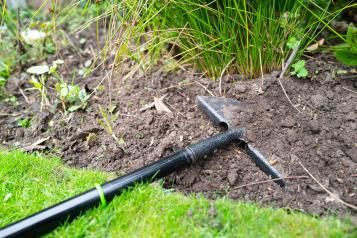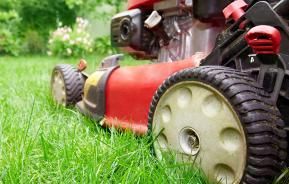
Lawn edging guide
Get a neat looking lawn
Does your garden need a quick makeover? Neatly trimmed lawn edges are one of the fastest ways to give any garden a lift, and trimming edges is easy once you have the right tools. Cutting new border edges can give your garden a new look and also make it easier to maintain. Follow our guide to create a lawn with style!
How to edge a lawn
Cutting your lawn edges regularly keeps them looking neat, so here are a few useful tools to add to your lawn maintenance kit:
- Long-handled edging shears enable you to cut grass edges without a trimmer and without having to kneel or bend over. Some versions have a rotatable head, allowing you to cut lawn edges against walls or paving.
- Single-handed edging shears look like large scissors. They’re useful for tackling areas of lawn edges next to walls or paving, or awkward areas too small for long-handled shears.
- Trimming grass edges by hand can be hard work, especially in large gardens or if the grass is long and thick. If you don’t want to edge your lawn by hand, powered grass trimmers make the job easy. Most powered grass trimmers have a head that can be rotated so that you can cut either horizontally or vertically, ensuring a superb finish.

How to cut a new lawn edge
Cutting new lawn edges is simple to do, and it’s a very effective way to give your garden a new look, create additional beds or change the shape of an existing border to provide extra space for plants. Here’s how to go about it.
- First, take time to decide on the line of the new border edge so that it fits in with the style of your garden. Straight lines work well in a formal design, and curves can help soften and divide long areas of your lawn. It’s a good idea to think about maintenance at this stage too – long sweeping curves look better and are easier to mow than lots of small fiddly ins and outs.
- Mark your planned borders out using string and pegs or use a hosepipe or a length of rope for a curved design. Look at the layout from different angles and viewpoints to make sure it achieves the effect you want to create – if possible, view it from an upstairs window to see the overall outline. It also helps to walk through the new areas you plan to create in the garden so that you can get the feel of the space.
- Once you’ve decided on the line of your edging and have marked it out, it’s time to cut the new lawn edges. A half-moon edger is ideal for this job. The curved blade makes cutting through turf easy, and the flattened area on top allows you to apply pressure with your foot when cutting. If you don’t have a half-moon edger, you can use a flat-bladed spade.
- Cut carefully through the turf along the marked-out line, taking small steps and overlapping your cuts slightly to create a continuous line.
- When you’ve cut all along the line, use a spade to remove the excess turf, sliding the blade of the spade horizontally under the turf to cut it off at the roots.
- Work around the edge of the bed, digging a shallow trench where the soil meets the turf. This makes trimming easier and stops the grass growing straight back into the bed.
- If you only have a small amount of excess turf, put it in your compost bin. To dispose of large amounts of turf, pile them up somewhere out of the way and they will eventually break down to give you fantastic border soil.
- Dig over your newly created borders to loosen any compacted areas and incorporate soil improver, then plant them up with new plants.

How to install lawn edging
An alternative to trimming lawn edges often is to install physical lawn edging. This stops your lawn from growing into your borders and reduces the need to trim the edges regularly with shears, as you can simply mow over the top of the edging instead.
Metal or plastic lawn edging (also called border edging) is available in most garden centres and comes in long strips or rolls. To install it, simply press it into the ground along the edge of a border so that the top of the edging is flush with the soil level in the border and no sharp edges protrude. This prevents injury to people or pets and allows you to mow over the edging without damaging your lawnmower. If the ground is very hard, you may need to use a spade to dig a shallow trench around the border before inserting the edging, and backfilling with soil afterwards to stabilise it.
Alternatively, if you have bricklaying skills, use bricks or setts (small square pavers) to create a stylish border edge, adding extra definition to your lawn and giving shape and structure to your garden.

FAQs
How do you use a half-moon edger?
Use a half-moon edger to cut new lawn edges. Hold the tool vertically with the curved edge of the blade resting on the turf, then press your foot down on the flattened area on the top of the blade to cut through the turf.
How deep should you edge your lawn?
When cutting new edging around a bed, make a 2-3in (5-7.5cm) deep trench where the lawn meets the bed. This gap stops grass growing into the bed from the lawn, and also makes it easier to trim the lawn edges with shears.
How to edge a lawn next to paving
If the top of the paving is lower than the level of the lawn, use long-handled shears to trim the edge. If the lawn is level with the paving, use grass shears with a rotating head that allows you to cut either horizontally or vertically. Alternatively, use an electric grass trimmer with an edging setting.








